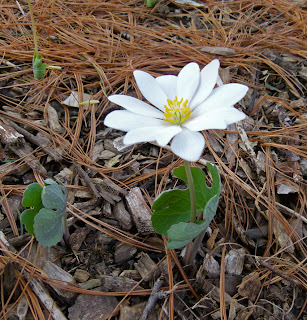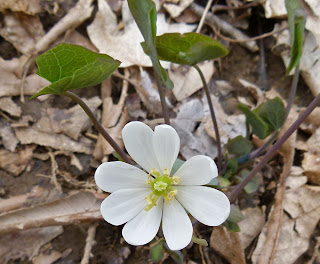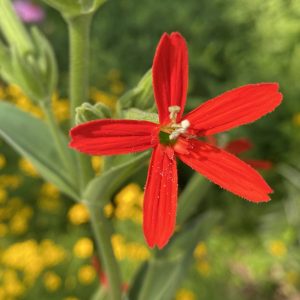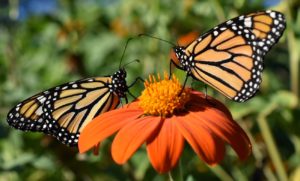Tavia Says:
The Bloodroot rhizome oozes an orange-red juice or sap when cut. Native Americans used the juice as body paint, lending the name Indian Paint. The rhizomes contain the alkaloid “sanguinaire,” an antibacterial, antifungal, and anti-inflammatory ingredient that is used in toothpastes and mouthwashes to help reduce dental plaque and gingivitis. Research indicates that it may also offer protection against skin cancer, however, the plant can be toxic even in small doses.
Another early spring flower that will be grown in the Woodland Fern Garden is Wild Ginger with its heart shaped leaves. The rhizomes of this plant have the taste and smell of true ginger. The flowers are small, and grow upon the ground, so they are easily missed by the casual view.
Tavia Says:
These flowers are pollinated by crawling and flying insects, such as ants, beetles, and flies. The blossom is the color and smell of raw meat, which attracts these meat eating insects. Native Americans used the rhizomes to flavor meat and fish dishes, and to make a tea for relieving many ailments, including indigestion, coughs, heart conditions, cramps, fevers, colds, and sore throats.
Sessile Trillium can be easily found along the banks of Little Huckleberry Creek. Trilliums do everything in threes – three leaves, and three petals on the blossoms. There are many kinds of Trilliums in other locations, but this is the only one we have at the Nature Preserve. If you find a different species, however, please let us know! The Sessile Trillium’s flower has no stem, and sits directly on the leaf junction. If you kneel down to smell the flower, it should have a strong carrion odor.
Tavia Says:
It is said that the scent resembles that of raw beef, which explains one of its common names, “Bloody Butchers.” The aroma has also been described as that of dead animal tissue and helps attract flies and beetles, which pollinate the plant. (And here I thought bees pollinated flowers! ~denapple)
Cutleaf Toothwort is another early bloomer at the Nature Preserve. By next week, the hillside above Little Huckleberry Creek should be covered with them.
Tavia Says:
The rhizome and leaves of this plant are peppery tasting. The leaves can be eaten raw or cooked, like other mustard greens. Native Americans made a poultice from the root and used it to treat headaches.
The Trout Lilies growing near each other are all clones – genetically the same and growing from one root system. They fill a hillside with small leaves, but only about 10% of those will actually blossom.
The leaves on a Twinleaf come in (you guessed it…) pairs. I think they resemble kidneys. The leaves will be small while the white flower blooms (with eight petals), then the leaves will grow larger when the bloom ceases.
Tavia Says:
The Latin name for this plant is Jeffersonia diphylla, and it was named for Thomas Jefferson by the American botanist William Bartram. Other common names include Ground Squirrel Pea, Helmet Pod, Rheumatism Roots, and Yellow Root.
There are two kinds of Rue Anenome. The “true” Rue has 5-10 showy sepals…














